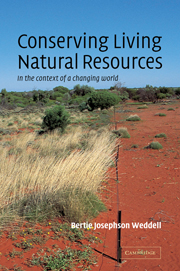Book contents
- Frontmatter
- Contents
- Preface
- Introduction: Balance and flux
- Methodology: Getting the information we need to manage living natural resources
- Part I Management to maximize production of featured species – a utilitarian approach to conservation
- Part II Protection and restoration of populations and habitats – a preservationist approach to conservation
- 7 Historical context – the rise of environmental concerns after World War II
- 8 Central concepts – the causes of extinction
- 9 Techniques – protecting and restoring species
- 10 Techniques – protecting and restoring ecosystems
- Part III Management to maintain processes and structures – a sustainable-ecosystem approach to conservation
- Postscript
- Appendix: Scientific names of organisms mentioned in the text
- Index
8 - Central concepts – the causes of extinction
Published online by Cambridge University Press: 05 June 2012
- Frontmatter
- Contents
- Preface
- Introduction: Balance and flux
- Methodology: Getting the information we need to manage living natural resources
- Part I Management to maximize production of featured species – a utilitarian approach to conservation
- Part II Protection and restoration of populations and habitats – a preservationist approach to conservation
- 7 Historical context – the rise of environmental concerns after World War II
- 8 Central concepts – the causes of extinction
- 9 Techniques – protecting and restoring species
- 10 Techniques – protecting and restoring ecosystems
- Part III Management to maintain processes and structures – a sustainable-ecosystem approach to conservation
- Postscript
- Appendix: Scientific names of organisms mentioned in the text
- Index
Summary
We saw in the previous chapter how events that followed World War II directed attention toward threats to biodiversity. Because of this situation, it became critical for scientists and resource managers to understand the processes that give rise to species and that allow them to persist on the one hand or cause them to become extinct on the other. This knowledge is a prerequisite to doing something about the situation.
In this chapter we consider how genetic changes in populations occur and how they result in local adaptation and evolution. We will also briefly consider how species arise, some of the consequences of small population size, and circumstances that make certain species and populations more vulnerable to extinction than others. More information on genetic variation, evolution, and the risks of small population size can be found in Frankel and Soulé (1981), Caughley and Gunn (1996), Futuyma (1997), Meffe and Carroll (1997), and Primack (1998).
Speciation: The formation of species
What is a species?
A species is generally regarded as a kind of organism that is reproductively isolated from other groups in nature. Thus, the species cannot normally interbreed with other species, and the members of a species share a common evolutionary history. Gene flow, the exchange of genetic information, can occur between members of a species but not between members of different species. This definition works well in many cases, but there are situations where it is problematic.
- Type
- Chapter
- Information
- Conserving Living Natural ResourcesIn the Context of a Changing World, pp. 194 - 224Publisher: Cambridge University PressPrint publication year: 2002



